[Retracted] Exploration of Energy-Saving Chilling Landscape Design Based on Algo for Group Intelligence
Abstract
Due to the influence of regional climatic conditions, the development of cold ecological tourism agricultural park in the north is slow, its landscape planning and design research lags behind, and there are still some problems. With the development of electronic computers, the previously unachievable optimization of engineering structures is now possible, while the traditional optimization methods cannot meet the requirements of modern computing due to the implementation constraints. The emergence of algo for group intelligences has made some applications of engineering structural optimization possible. Group intelligence is the characteristic of a system in which the collective behavior of low-level individuals interacting locally with their environment forms an overall pattern of consistent functions. This paper presents a study of energy-efficient cold landscape design based on algo for group intelligences and analyzes the problems that arise in the ecological landscape design of cold urban settlements. Then countermeasures are proposed to solve the problems. The linear model is replaced by the determination of the weight of the evaluation index of the energy-saving design of frozen landscape. And take it as a new migration model. Then, based on the weight of the evaluation index, the group algorithm analysis in landscape design is proposed, which is a generalized definition of the standard model. The experimental results show that the algo for group intelligence outperforms another algorithm in terms of solving ability to the extent that the average optimization ability is improved by 13.45%, so the algo for group intelligence demonstrates its superior ability to take into account both local and global search. Therefore, the use of algo for group intelligences to build an energy-efficient society is a necessary path for China’s development, and the construction of energy-efficient gardens is an important part of building an energy-efficient society, and the application of energy-efficient concepts to modern landscape design is an inevitable trend in the development of urban landscaping.
1. Introduction
Energy consumption in buildings has become one of the three major energy consumers in China, together with industrial energy consumption and transportation energy consumption [1]. The uncontrolled squandering of the main resources, the reckless pollution of the environment, and the shortage of water, land, minerals, and other resources, as well as the low development and utilization of some new energy sources, make the contradiction between human and energy resources increasingly prominent [2]. The spatial creation of the landscape of cold urban settlements must “naturally” use the natural environment, adapt to local conditions, use the regional advantages to turn its disadvantages into favorable factors, and create a landscape environment with regional characteristics [3]. From the perspective of the composition of urban green space, cold landscape is an important part of urban development space, which plays an important role in improving the quality of urban environment, enhancing the overall image of the city and accelerating urban economic development [4]. In cold regions, many residential buildings use active means to meet the humanization of the indoor environment, which in turn increases building energy consumption, which is a huge waste for residential buildings in cold regions with high energy-saving appeals [5]. Natural resources have long been unable to withstand the endless exploitation of human beings, and the environment on which human beings depend for survival has become full of holes [6]. Therefore, applying ecological and environmental principles to the design and planning of urban public landscapes and proposing public landscape planning and design methods can improve the practical role of public landscapes in energy conservation and environmental protection.
Energy-efficient gardening, as an important part of building an energy-efficient society, plays an extremely important role in implementing the scientific concept of development and creating resource-efficient and sustainable development in the landscaping industry [7]. The core content should be studied in terms of building site selection, zoning, building and road layout orientation, building orientation, building body shape, building spacing, dominant direction of winter and summer monsoons, solar radiation, etc. We will analyze the factors that determine the climate and make full use of them through the planning and layout of the residential area, so as to form good living conditions and a microclimate environment that is conducive to energy saving. However, the development and construction of domestic cold landscapes are still in the initial stage, and blind development, imitation of countries, and quick success are inevitable, such as the planting of seedlings in the opposite season, planting against the environment, introducing a large number of species, and even filling lakes to create gardens are common [8]. At present, there are not many domestic and theses on the study of ecological landscape design in cold urban settlements. In the design of cold urban landscape, design should be combined with ecological design from a holistic perspective to enhance the livability of cold urban areas and promote respect for nature and protection of nature.
As part of the public green space, urban parks are a platform for people to relax and get close to nature, and they are an indispensable green life facility in the urban infrastructure [9]. Under the boom of creating energy-saving green landscape in cities, the concept of energy-saving greening, i.e., “choosing the greening mode with the least amount of land, the least amount of water, the least amount of financial allocation, and the least disturbance to the surrounding ecological environment,” is a landscape construction concept in line with the theory of sustainable development [10]. In its specific design process, we should not only emphasize its artistry, but also pay more attention to its energy-saving and environmental protection role, so as to create a warm, healthy, and sustainable urban living environment for human beings. When the inevitability of sustainable development becomes the common understanding of the whole society, how to apply energy-saving technology in the design of cold-land residential buildings becomes an important research topic.
The innovation of the research is that through the overview of the landscape planning and design system and methods of the cold botanical garden, this paper puts forward an energy-saving cold landscape design method based on swarm intelligence algorithm and studies the evaluation index weight of energy-saving cold landscape design. Then, based on the weight of the evaluation index, the group algorithm analysis in landscape design is proposed, which is a generalized definition of the standard model. The planning and design of cold ecological sightseeing agricultural park landscape adopts modern algorithms for swarm intelligence and mapping. While traditional gardens are nutritious, they also pay attention to the combination with local culture.
2. Design Ideas of Energy-Saving Cold Landscape Based on Group Intelligence Algorithm
2.1. Energy-Saving Cold Landscape Design Method Based on Group Intelligence Algorithm
Therefore, we analyze the environmental characteristics of ecological landscape design in cold urban residential areas and propose a method for energy-saving cold landscape design using algo for group intelligences. In this regard, an environmentally friendly and energy-saving landscape design method is proposed, which focuses on the use of resources and energy. The route of energy-saving and environment-friendly public landscape design is shown in Figure 1.
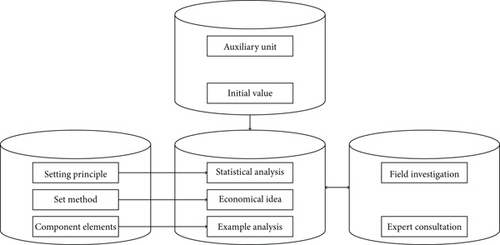
Therefore, the basic encoding method to convert the solution into a form that is convenient for GA operation is the binary encoding method. That is, the solution of the general problem is represented as a binary string, and the space in which the solution is encoded becomes the encoding space. Landscape base electricity needs to ensure the effective transmission efficiency of the power system. Its overall landscape electric energy environmental protection mode diagram is shown in Figure 2.
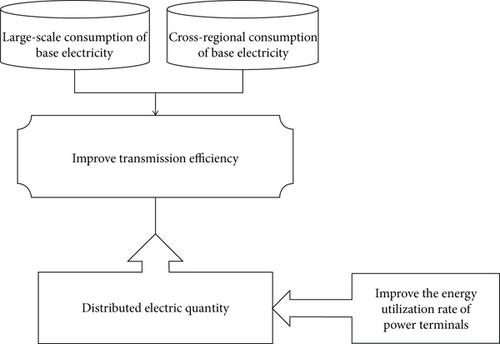
Direct analysis methods can stop and give a solution at any time because they deal with complete solutions. However, branch-and-bound, dynamic programming, and separation and conquest all construct solutions during the search process, so they cannot stop and give a complete solution until the entire search process is completed. Therefore, when using the ACO to solve a specific problem, the first step is to solve how to map the movement path of ants in the ACO to the solution of the problem. Ant colony algorithm can be used to solve the path planning problem, and the algorithm is implemented in JAA language. Although this method has not been studied for a long time, preliminary studies have shown that it is a promising algorithm. It simplifies the binary discrete particle swarm algorithm into basic components and provides a base point for further exploration of the nature of discrete particle swarm algorithm in the future. In addition, sunrooms are a useful addition to residential buildings to reduce energy consumption, and the rooms connected to them not only reduce a large amount of heat loss, but also reduce the energy required for cooling.
where p is the sample point and Mi is the average deviation of data.
Therefore, the good or bad construction of the pheromone and heuristic information model directly affects the effectiveness of the ant colony algorithm. In addition, a leader particle is introduced into the algorithm. This particle uses a separate update rule similar to the ACO pheromone and provides information to all other particles. Based on the “self-regulating and self-designing” ecological properties of the ecosystem, the algorithm restores some or all of the natural properties of the cold landscape shorelines and sections, reconstructs the natural ecosystem of the cold landscape, and creates a natural environment rich in biodiversity. The core is to carry out scientific planning and design guided by the overall development plan of the city, with reasonable allocation of flowers and trees, three-dimensional layout of trees, irrigation, and grass, so that while improving the ecological environment of the city, urban residents can enjoy a beautiful ecological living environment and cultivate their morale.
2.2. Determination of Evaluation Index Weight of Energy-Saving Landscape Design in Cold Region
Since garden construction is inextricably linked with urban electricity and water energy, we should maximize energy conservation of water and electricity and other resources, improve the utilization rate of resources, and reduce energy consumption in all aspects of garden design, construction, maintenance, and postmanagement. On the basis of favorable plant growth and maintenance of biodiversity, reduce the large-scale transformation of site topography and use site topsoil as planting soil as much as possible, so as to maintain biodiversity and reduce the economic costs required for exotic planting soil.
Next is the hierarchical total ranking and assignment. The hierarchical total ranking is the weight value of each indicator for the total target (energy-efficient landscape design for urban parks), which is the weight of each indicator that is ultimately needed. As the length of the residential building increases, the curve flattens out, i.e., when the length of the building grows to a certain limit, the growth rate of the resulting energy efficiency decreases to a nonsignificant rate. Let there be Y data ants in the matrix space, i.e., with Y species solutions, and then combine these solutions together to form the initial ant data population, i.e., the ant data genes, and locate the ordinal numbers. In addition, the pheromone and heuristic information model compatible with the solution will be defined and initialized in the initialization of the ant colony intelligence algorithm. Pheromone importance factor refers to the influence of pheromones produced by species on ants during their movement. Heuristic function importance factor reflects the relative importance of heuristic information in guiding ant colony in path search. The heuristic information of the inner loop ant colony algorithm for solving the model represents the heuristic information for the decision-making level to select the process schedule. Different from pheromone information, heuristic information depends on the characteristics of the problem itself. It has nothing to do with the information of the solution generated in the iterative process.
The framework of the ant colony optimization algorithm is shown in Figure 3 below.
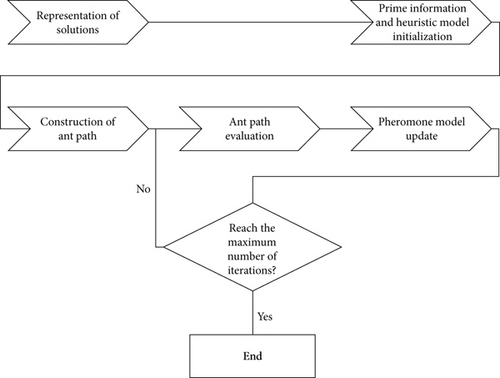
Management intensive landscape refers to the minimum investment of human, material, and financial resources in all phases of garden construction, especially in the postmanagement and maintenance phase. Due to insufficient field research in the early stage, the designer cannot reasonably lay out the design lot. And the design cannot comprehensively consider the functional needs of the lot, the location of landscape nodes, the layout of viewpoints, and other issues. Thus, it is not possible to project a reasonable proportion of hardscape and green landscape. Thus, in the indirect representation of the real number encoding scheme, the real value stored in the particle only indicates the tendency of the element in the particle to take a certain value, and according to these tendencies, the solution arrangement is obtained by “decoding.”
3. Application Analysis of Group Intelligence Algorithm in Energy-Saving Cold Landscape Design
3.1. Analysis of Group Algorithm in Landscape Design
The population algorithm provides a general framework for solving optimization problems of complex systems, which does not depend on the domain and type of the problem. At this time, there is a complex coupling between the decisive variables for solving the problem and the objective function, to find the influencing factors according to the problem analysis, the influence of these factors on the objective function by some combination to find a set of optimal coefficients, that is, the solution of the problem. The trend of the experimental acceleration ratio of the algo for group intelligence is shown in Figure 4.
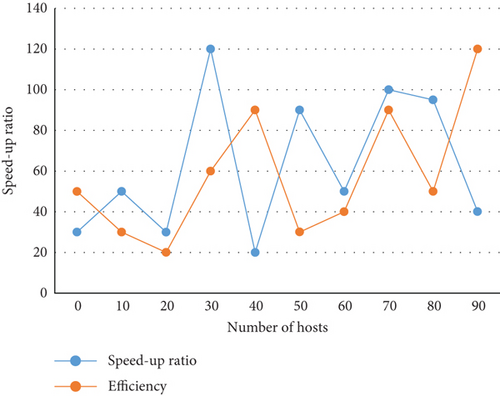
First, the decision variables and their various constraints are determined, i.e., the individual manifest X and the solution space of the problem are determined. The initial population is generated randomly: for the binary-encoded population, the bit strings are generated randomly according to the encoding length of the solution. Sometimes it is not necessary to search all the solutions; for example, the characteristics of the fitness function (linear) and the search space (convex region) in linear programming only need to search along the boundary of the search space. There are also methods such as dynamic programming and branch-and-bound, which can cut off part of the solutions in the search space and only need to deal with part of the solutions. Ecological landscape is different from landscape design that simply aims at visual enjoyment or meeting functional needs but elevates the landscape to the height of protecting the ecological balance of the city and improving the whole human ecosystem and living environment. Use integers to store the position of each of its elements in its solution arrangement rather than the arrangement itself. The velocity of each particle is formed by the left-right movement of its element positions, thus forming a judgment matrix for the velocity of the particle. Based on the obtained judgment matrix, the values were entered into the computer software Yaahp, and after the consistency test CR<0.05, the weight values of each element for the elements of the previous layer were obtained, and the results are shown in Table 1.
| Evaluation of conservation-oriented landscape design | B1 water saving | B2 energy saving |
|---|---|---|
| B1 water saving | 0.549 | 0.482 |
| B2 energy saving | 0.784 | 0.652 |
| Weight | 0.128 | 0.336 |
Second, the individual encoding method representing the feasible solution is determined, i.e., the individual encoding type B and the search space of the population algorithm are determined. Due to the limitation of population size and the length of bit strings, each bit string has an intrinsic probability of being generated. The larger the population, the higher the probability of possible patterns and bit strings appearing, and vice versa will be smaller. The evolutionary process of the algo for group intelligence is shown in Figure 5, where the evolutionary mean is 2109.1 Hz, and Figure 6 shows the deviation curve of the algorithm from the SVM in this chapter.
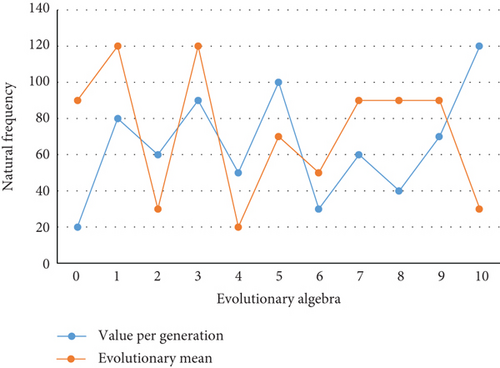
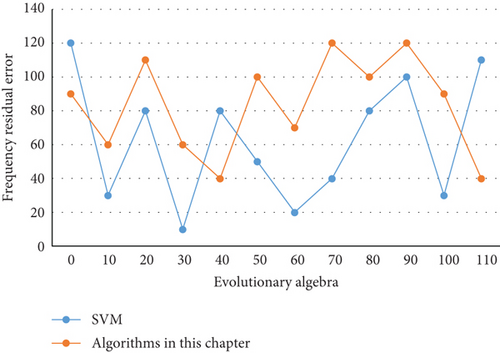
Even when the defined fitness function is discontinuous, nonregular, or noisy, the population algorithm can find the global optimal solution with a high probability. The design approach incorporating ecological theory creates landscapes that focus on the combination of ecology and art, adapt to modern society, have high artistic standards, and incorporate ecological ideas and techniques. The particle swarm algorithm of continuous type is then used to update the position of each element in its arrangement, which forms a new position of the particle expressed in real values so that the selection is focused on searching in promising regions of the search space. The genetic material in the population is then changed by crossover or mutational recombination in order to develop new points in the search space.
Finally, the decoding method is determined, i.e., the correspondence or conversion method from individual encoding type B to individual expression type X is determined. Then, the intermediate results of these real values are sorted by using the principle that the element with the smallest value is the first to be scheduled, and the relative position of each element in the arrangement is determined to obtain the updated solution arrangement. When the current position of a particle is greater than its best position, the velocity of the particle decreases (current velocity - random number multiplied by a system parameter); and vice versa increases (current velocity + random number multiplied by a system parameter). In this rule, the largest real number will be selected first as the first position of the new scheduling scheme, and the slightly smaller real number will be selected as the second position of the new scheduling scheme. There is no any special requirement for the search space (such as connectivity and convexity), and only adaptive information is utilized without other auxiliary information such as derivatives, which allows a wider range of adaptation. In ecological conservation design, the positive significance of ecological conservation design is that it closely connects ecological research with landscape design and establishes a scientific view of design theory. The speed of convergence of an evolutionary algorithm as an optimization application is basically determined by the selection operator or, more precisely, by the selection pressure exerted on the search process by the selection operator. Different coding methods and different operations of the population operator are required for different optimization problems. They are closely related to the specific problem being solved, and thus, the degree of understanding of the problem being solved is crucial to the success of the population algorithm application.
3.2. Analysis of Swarm Operators in Group Intelligence Algorithm
The evaluation function of the algo for group intelligence is a function that reflects the degree of merit of the solution expressed by the individuals in the group, which is equivalent to the fitness function of the evolutionary algorithm. The population operator is the operator that operates on the population in the population algorithm, which reflects some activity process of the population. In the algo for group intelligence, the components of position and velocity are no longer a single number but a fuzzy set of possible values of this component. Since the update of the pheromone directly affects the selection probability, if the update of the pheromone is made more diverse, the selection of the path will be diversified. Therefore, the simulation results of the Apriori algorithm, SVM algorithm, and population algorithm are compared, as shown in Figure 7.
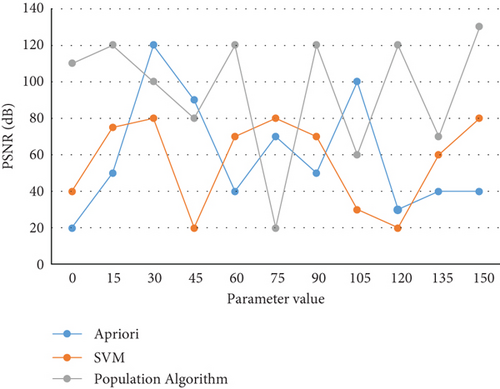
First of all, for the objective function and the evaluation function, a characteristic of the genetic algorithm is that it uses only the objective function value of the problem to obtain the relevant search information for the next step. Genetic algorithm processes multiple individuals in the population at the same time, that is, it evaluates multiple solutions in the search space, which reduces the risk of falling into the local optimal solution. At the same time, the algorithm itself is easy to realize parallelism. Genetic algorithm basically does not need to search the knowledge of space or other auxiliary information, but only uses the fitness function value to evaluate individuals; on this basis, genetic operation is carried out. The use of the objective function value is reflected by evaluating the fitness of the individual. An appropriate fitness function is constructed to transform the chaotic system parameter problem into a multidimensional optimization problem, and then the global search capability of the fuzzy discrete particle swarm algorithm is used to solve this optimization problem. One advantage of the fuzzy discrete particle swarm algorithm is that it can maintain the continuous nature of the particle swarm algorithm, since the particle swarm algorithm has excellent performance in solving continuous domain problems. By introducing fuzzy sets, it is hoped that discrete problems can be solved in a similar way to continuous problems without losing the efficiency of the particle swarm algorithm. For the slab type building, which is more commonly used in residential building design, when the building length is determined to be less than the optimal side length corresponding to a certain floor area, the building length should be reduced as much as possible, while the depth of the building should be increased. This will greatly reduce the building’s volume factor, which is very beneficial to the energy-saving design of residential buildings. For the algorithm in this chapter and Apriori algorithm, fij(A) refers to the optimal fitness value of the algorithm in the case of particle number i and space dimension j. The optimization percentage results of the two algorithms are shown in Table 2.
| f1 | f2 | Average optimization percentage | |
|---|---|---|---|
| Algo for group intelligence | 27.19% | 46.22% | 36.71% |
| Apriori | 18.37% | 28.15% | 23.26% |
From the optimization percentages of the two algorithms compared in Table 2, it can be seen that the algo for group intelligence outperformed the other algorithm in terms of solving power by 13.45% in terms of average optimization power; thus, the algo for group intelligence demonstrated its superior ability to take into account both local and global search.
The second is the fitness scale transformation, in which the probability of each individual being inherited into the next generation population is determined by the fitness of that individual in the genetic algorithm. In high-rise residential buildings, the energy consumption index of slab-type residential buildings with north-oriented enclosed traffic corridors is about 7% lower than that of multistory slab-type residential buildings. Under the condition of similar building area, the heat consumption index of high-rise tower residential buildings is about 11%-17% higher than that of high-rise slab residential buildings, and the tower residential buildings with complex body shape and too many concave and convex surfaces are not good for energy saving. The score of underground space utilization is the lowest, because in terms of urban parks, the landscape is usually above ground, and the demand for underground space is less, and it is often used as a parking lot. However, the use of underground space should not be neglected. For parks with limited space and carrying capacity, underground space can be used to create more diverse places. In order to make the group algorithm can directly solve the scheduling problem, a maximum ranking rule is proposed, which uses each location component value between objects that has a size order relationship. And it is combined with a random key encoding method generated to transform the successive positions of objects into a feasible scheduling scheme. The process of the scheduling scheme is different from that of the normal particle swarm algorithm in that two operations are added to the algorithm, one is to use the normalization operation after the position update to constrain the position values to the interval [0, 2], and the other is to call the defuzzification operation to obtain an integer vector before calculating the fitness in order to solve the fitness function later. The results are shown in Figure 8 for single-score samples with nominal values of 1.20 μm and 2.40 μm for different set thresholds of the population operator.
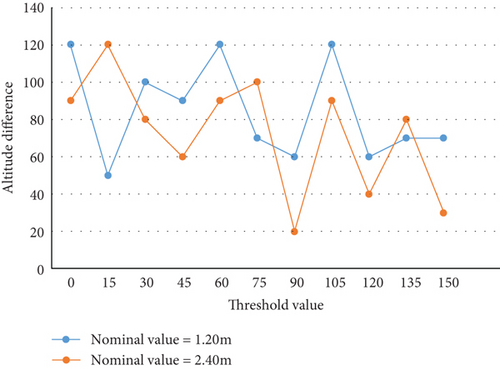
Finally, the method of dealing with constraints, when dealing with constraints, only for specific application problems and the characteristics of constraints. Then, considering the computing power of genetic operators, different processing methods are selected in genetic algorithm.The energy-saving chilling landscape design uses a domain search algorithm. The key idea of this algorithm is to exchange the positions of two adjacent operations, and when the current exchange produces a solution that is better than the original one, we accept this exchange and update the value of the solution. This method does not change any part of the particle swarm algorithm calculation, but only converts the particle positions from real space to integer space when computing the fitness function. The conversion is very simple, either by taking the integer part of the particle positions directly or by rounding the function. The weight size is related to the reasonable traffic organization, and the smooth road planning and space division can maximize the space utilization and avoid unnecessary land waste, so the reasonable traffic organization is crucial.
4. Conclusions
Urban public landscape design has become an important design area of concern for urban builders at this stage. With the booming development of cold cities and the influence of ecological construction and low-carbon economy in the world, the sustainable development of cold cities has attracted much attention. Energy saving is the objective requirement of modern ecological civilization. Modern landscape design has emerged as a result of the dual destruction of nature and human body and mind by industrialization. The most fundamental difference with previous gardening is that its main creation object is the overall human ecosystem. The structure of the algo for group intelligence is simpler, the parameters of control are less, the robustness of the algorithm is stronger, etc. Facing the current situation of resource scarcity in China, landscape greening should implement the scientific concept of development, follow the requirements of the construction of an energy-saving society, and put energy conservation into concrete implementation in landscape design. This paper summarizes the relevant energy-saving strategies based on the climate of cold regions and the thermal characteristics of residential buildings. The first part of this paper introduces the background and significance of the research and then introduces the main work of this paper. In the second part, the method of energy-efficient cold landscape design based on algo for group intelligence and the determination of the weight of energy-efficient cold landscape design evaluation indexes are reviewed. The third part is the core of the paper, from the analysis of group algorithm in landscape design and the analysis of group operator of group intelligent algorithm, completing the description of the application analysis of group intelligent algorithm in energy-saving cold landscape design. The last part of the paper is the summary of the whole work.
However, this algorithm has some limitations. When the algorithm is used in the overall architectural scheme design, it lacks the unified consideration of architecture and landscape. The unification of architecture and landscape is the ultimate goal of current urban planning. Whether from architectural design or landscape design, we can not only consider a single factor one-sidedly. It needs to be analyzed in future ide research.
Conflicts of Interest
The author declares no known competing financial interests or personal relationships that could have appeared to influence the work reported in this paper.
Acknowledgments
This work was supported by the 2020 Basic Scientific Research Business Fee Scientific Research Project of Heilongjiang Provincial Colleges and Universities: construction of intangible cultural inheritance and training base for college students’ ice lantern and ice sculpture making skills (high-level key project, Project No. 2020-kyywf-0908).
Open Research
Data Availability
The data used to support the findings of this study are available from the corresponding author upon request.




